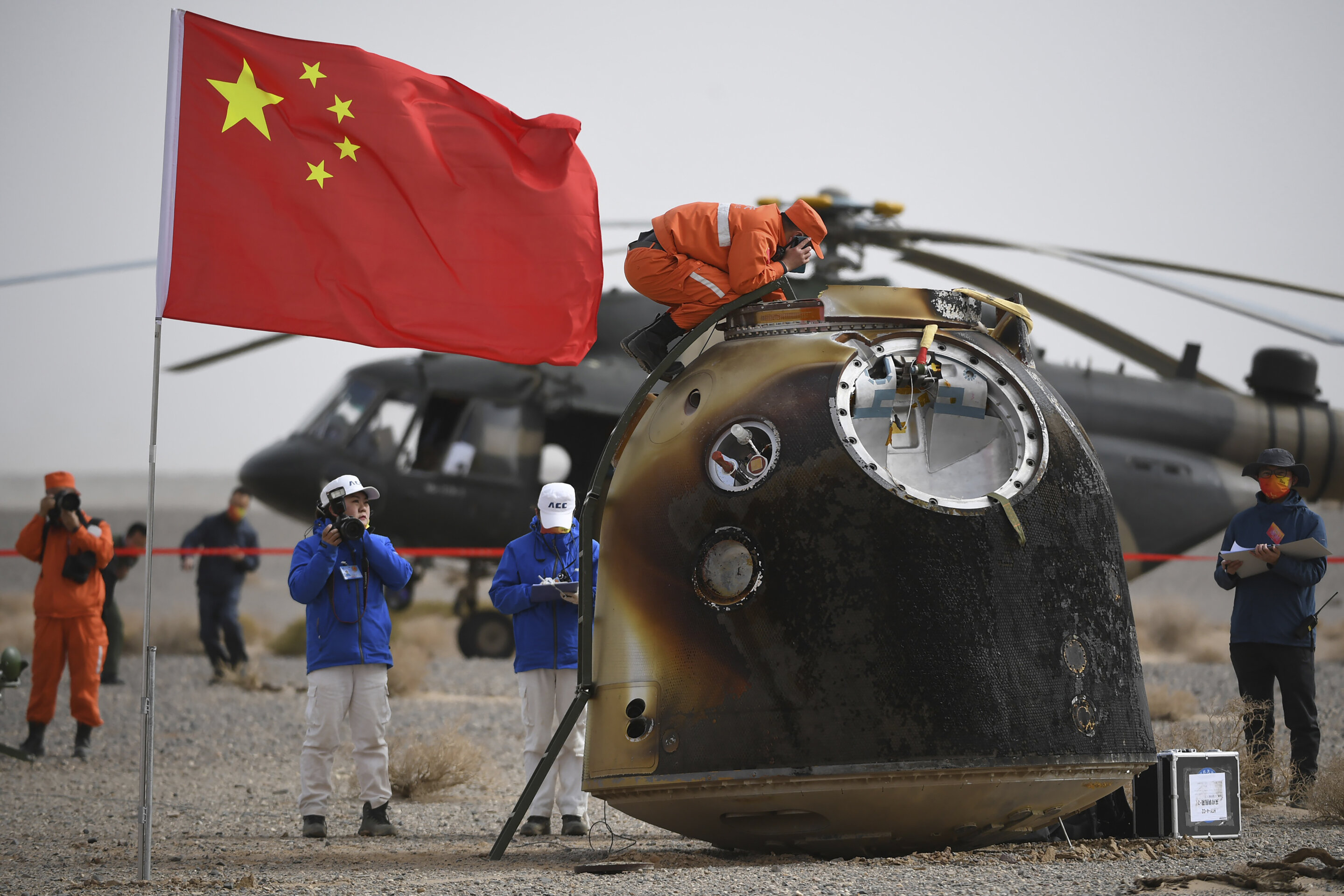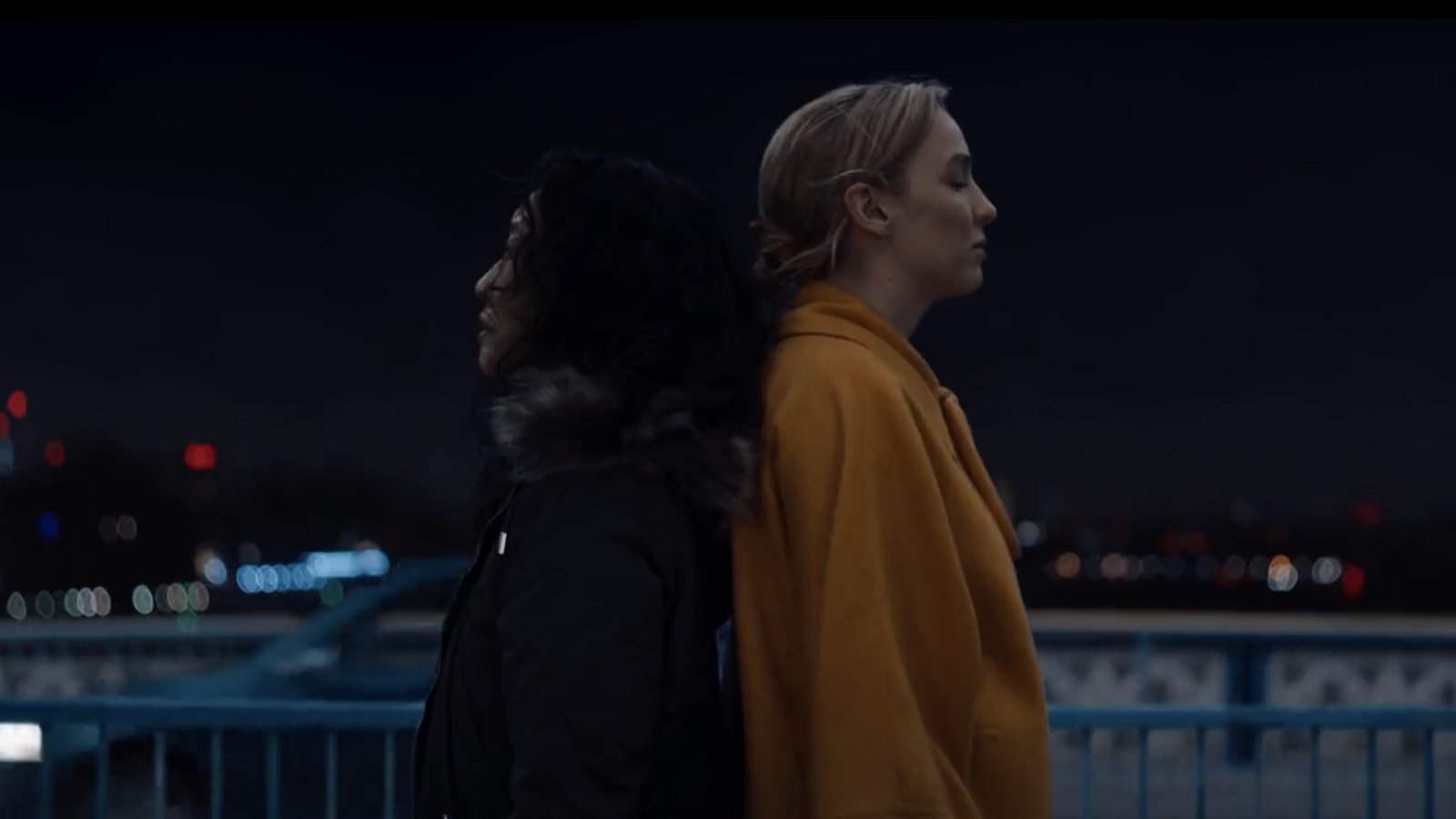#How the wildfires got so bad
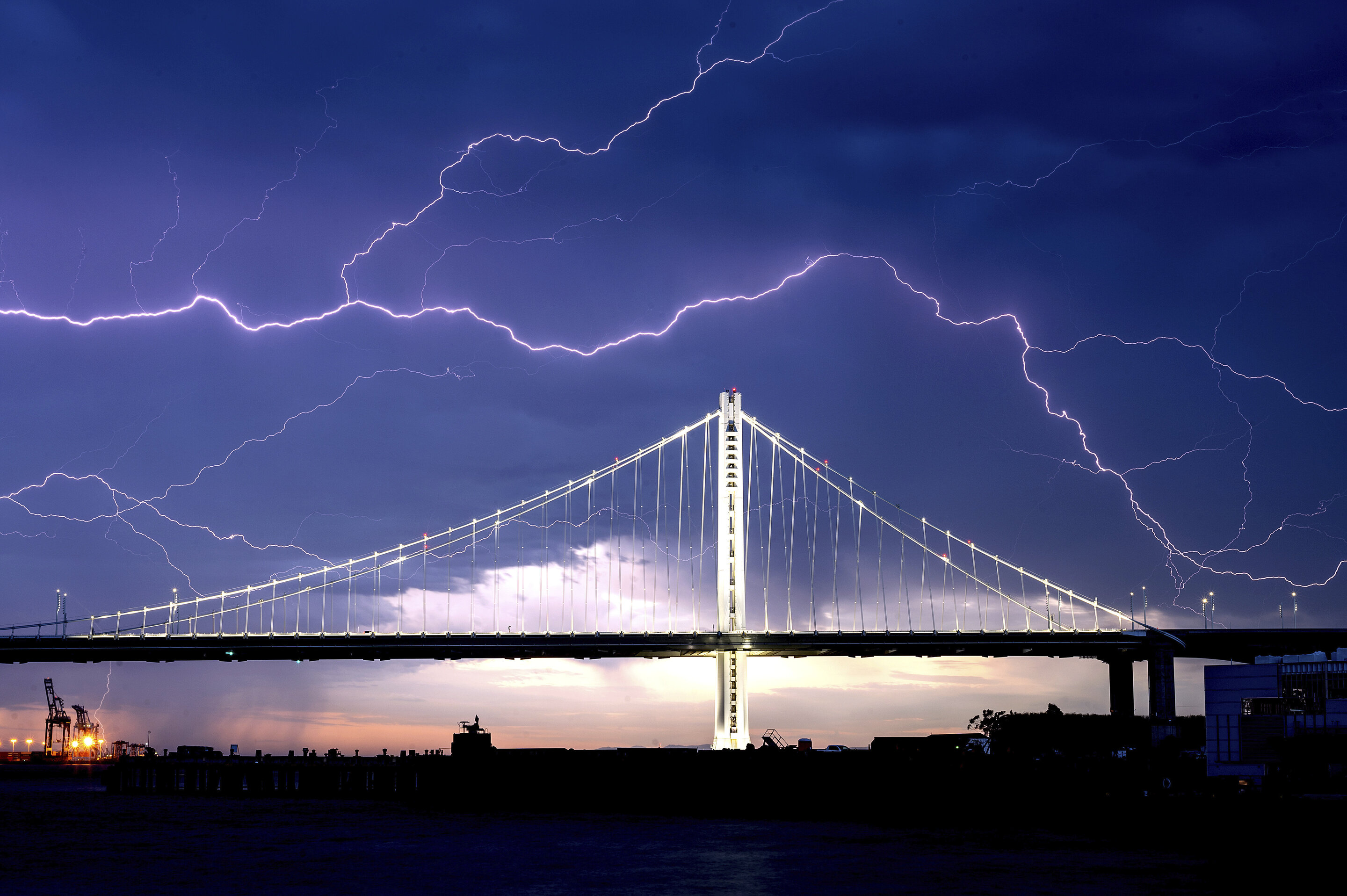
“#How the wildfires got so bad”
If you want to watch Movies or TV series visit the Dizi.BuradaBiliyorum.Com

It began as a stunning light show on a mid-August weekend—lightning bolts crackling in the skies over Northern and Central California, touching down in grasslands and vineyards.
The National Weather Service warned that the dry lightning striking a parched landscape “could lead to new wildfire.”
It turned out to be a huge understatement. Thousands of bolts ignited hundreds of fires in California and at least one in Oregon, setting the stage for some of the most destructive wildfires the West Coast states have seen in modern times.
One month later, firefighters are still battling them, and at least 34 people have died in California, Oregon and Washington.
“What really was jaw dropping for people was the fact that this really changed the paradigm that people have in terms of their sense of security,” said Oregon Department of Forestry spokesman Jim Gersbach. “These burned so close to populated areas, driven by this wind—basically unstoppable.”
The massive wildfires renewed a longstanding debate over whether climate change or a lack of aggressive forest management played the bigger role this time around. Numerous studies have found that a warming Earth, which leads to higher temperatures and dryer landscape, increases the likelihood of extreme events and contributes to their severity. But many experts have also argued that more needs to be done to thin forests and reduce debris so that flames have less fuel.
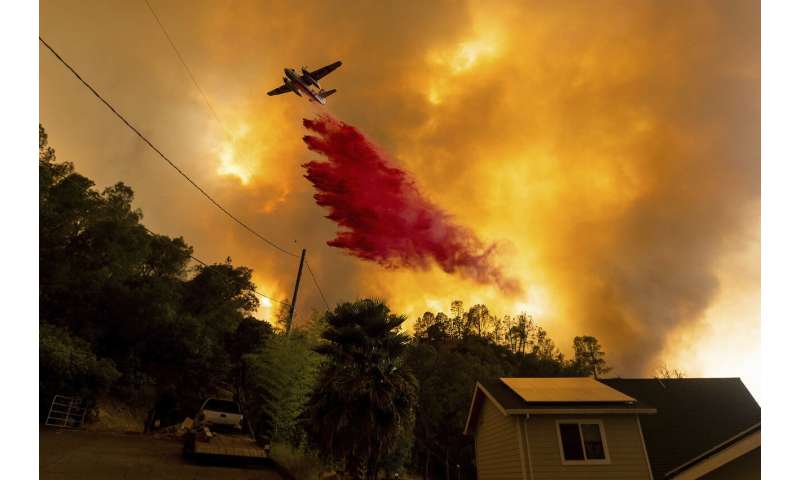
Before the cluster of lightning strikes, the West’s fire season had been slightly more severe than normal. In Oregon, officials had decided to not let fires grow, ordering that even small blazes be smothered quickly by aircraft, so throngs of firefighters wouldn’t be needed and potentially spread the coronavirus, Gersbach said.
But then came the weekend of Aug. 15-16.
“It’s been a pretty insane 12 hours across the Bay Area,” the National Weather Service forecasters reported, after the lightning storm during which white-hot bolts licked at the span of San Francisco’s landmark Bay Bridge.
But that was just Act I.
Act II came three weeks later, when another freak weather phenomenon occurred.
A vast high-pressure zone stretching from Alaska to the desert in the Southwest gave Denver a summer snowfall while pushing warm, dry winds toward the Pacific coast, said Greg Jones, a professor and research climatologist at Linfield University in McMinnville, Oregon. Normally, the winds that time of year go in the opposite direction.
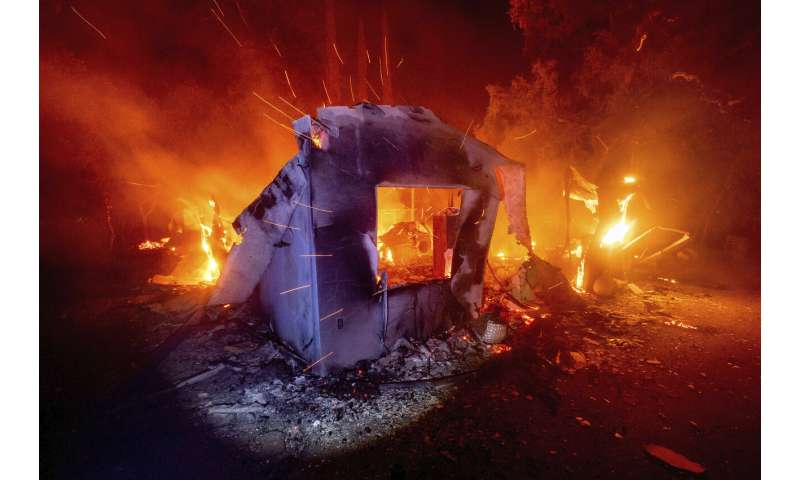
Those gusts pushed the fires through trees and brush that had been drying out all summer, causing the blazes to explode in size and sending them rushing into towns and rural homes. Many residents barely had time to flee with just the clothes on their back.
Jones called the weather conditions “likely a once in a generation event.”
For the first time ever, five megafires—defined as covering at least 100,000 acres (405 square kilometers—were ablaze simultaneously in Oregon last week.
Smoke covered the West Coast states, creating some of the most hazardous air quality in the world. Seattle’s iconic Space Needle was all but hidden in brown haze, topped with an American flag that drooped as if in surrender. The smoke stretched clear across the continent and even blew over parts of Europe.
Armies of firefighters responded. Clad in orange fire-resistant suits and helmets and carrying Pulaski hand tools, they trudged across blackened earth toward the flames. National Guard troops joined the effort. Even local residents tried to save homes by gouging firelines by hand and with excavators and bulldozers.
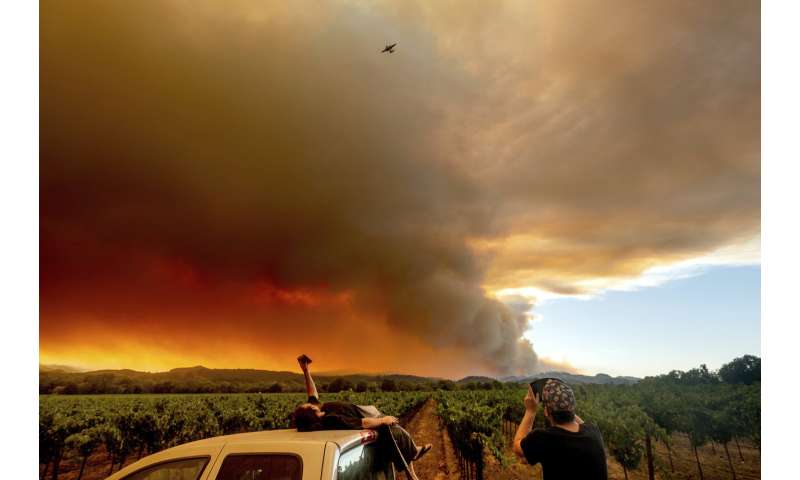
“You gotta pull together in times like this because it’s like a war zone out here,” Kerry Kuenzi, an area resident who with several dozen others fought a monster fire in the community of Scotts Mills, Oregon, told The Oregonian/OregonLive.
The Beachie Creek Fire he faced covered less than a square mile (2 square kilometers) on Sept. 7. Overnight, driven by high winds and extremely dry fuels, it grew to 205 square miles (530 square kilometers), fire managers said.
New fires continued to ignite in California and Oregon. One burned near Interstate 5 in Oregon not far from the California state line, turning most of the towns of Phoenix and Talent into a blackened landscape littered with the twisted remains of mobile homes and other structures.
The flames were so intense that firefighters sometimes had to retreat, including those facing a blaze threatening Portland’s southeastern suburbs.
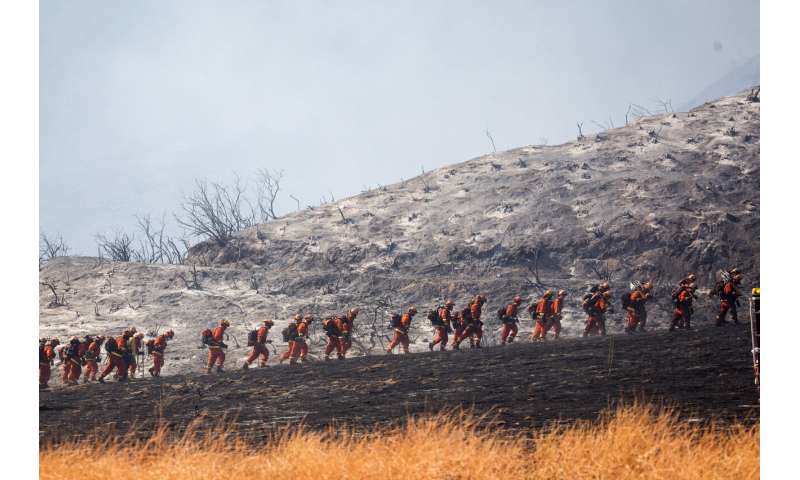
“You can’t really stand there with a hose when you’ve got 30-mile-an-hour winds and dry fuels,” Gersbach said.
Firefighters from across the nation and Canada have descended on the region to help fight the blazes: There are more than 17,000 in California fighting over two dozen major fires, and more than 6,000 facing about a dozen blazes in Oregon.
About 5,300 square miles (13,700 square kilometers) have burned this year in California—more than ever before, Cal Fire said. In Oregon, the figure is about 1,560 square miles (4,000 square kilometers), nearly double the 10-year average.
Residents are desperately hoping for rain to wash away the choking wildfire smoke. Predicted rains in fire-hit parts of Oregon haven’t arrived yet. California remains dry, though calming winds and lower temperatures—caused in part by the smoke blotting out the sun—have aided firefighters. Small amounts of rain are in the forecast for far northern California and the Sierra Nevada.
-
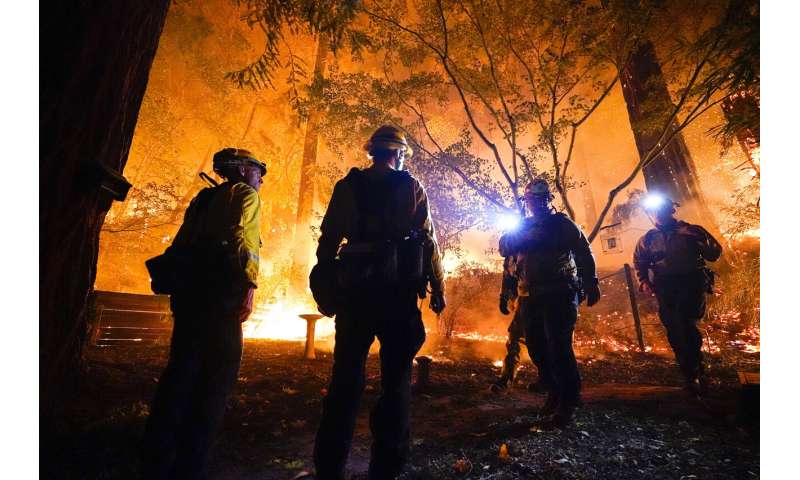
In this Aug. 21, 2020, file photo, firefighters make a stand in the backyard of a home in front of the advancing CZU August Lightning Complex Fire in Boulder Creek, Calif. Two unusual weather phenomena combined to create some of the most destructive wildfires the West Coast states have seen in modern times. (AP Photo/Marcio Jose Sanchez, File)
-
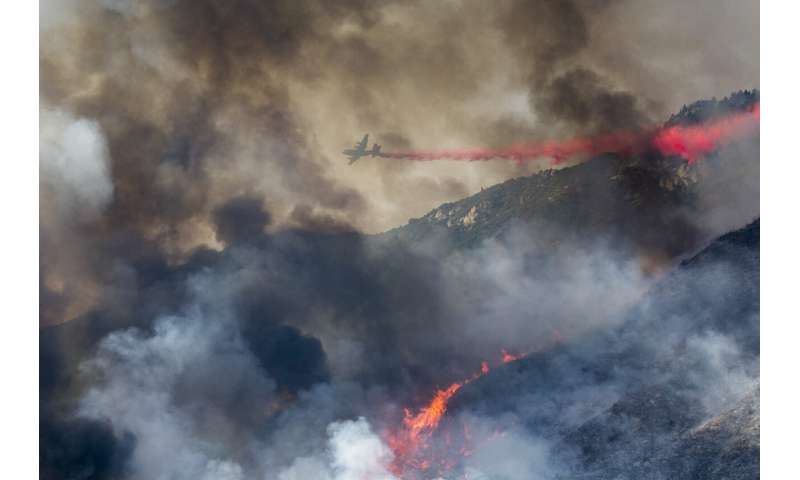
In this Sept. 5, 2020, file photo, an air tanker drops retardant as a wildfire burns at a hillside in Yucaipa, Calif. Two unusual weather phenomena combined to create some of the most destructive wildfires the West Coast states have seen in modern times. (AP Photo/Ringo H.W. Chiu, File)
-
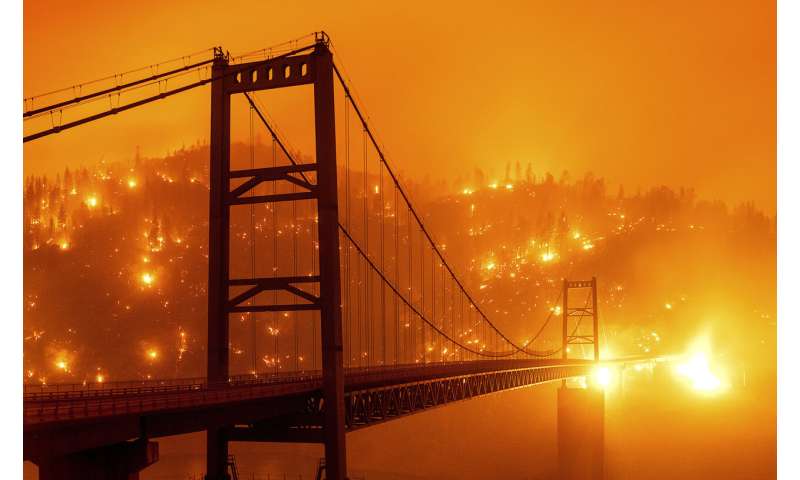
In this Sept. 9, 2020, file photo, taken with a slow shutter speed, embers light up a hillside behind the Bidwell Bar Bridge as the Bear Fire burns in Oroville, Calif. Two unusual weather phenomena combined to create some of the most destructive wildfires the West Coast states have seen in modern times. (AP Photo/Noah Berger, File)
-
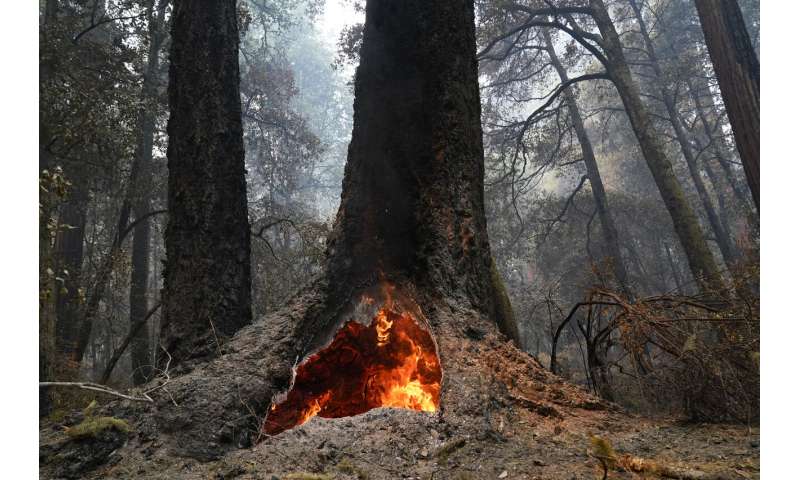
In this Aug. 24, 2020, file photo, fire burns in the hollow of an old-growth redwood tree in Big Basin Redwoods State Park, Calif. The CZU Lightning Complex wildfire tore through the park but most of the redwoods, some as old as 2,000 years, were still standing. (AP Photo/Marcio Jose Sanchez, File)
-

In this Sept. 9, 2020, file photo, flames lick above vehicles on Highway 162 as the Bear Fire burns in Oroville, Calif. The blaze, part of the lightning-sparked North Complex, expanded at a critical rate of spread as winds buffeted the region. (AP Photo/Noah Berger, File)
-
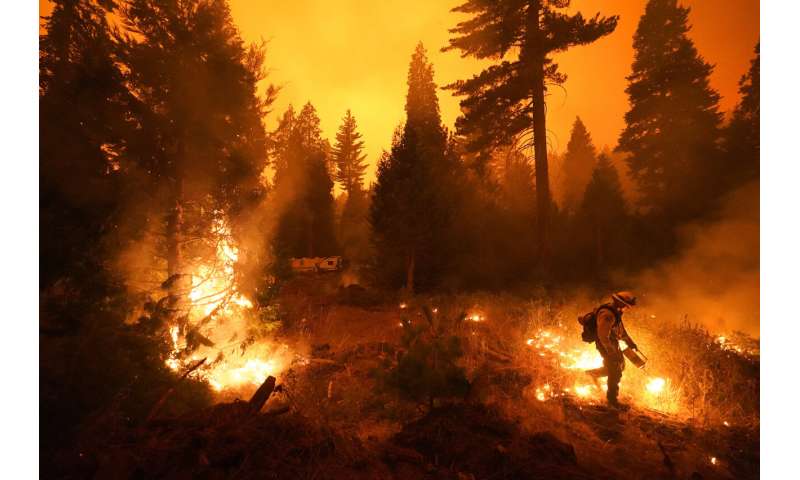
In this Sept. 6, 2020, file photo, firefighter Ricardo Gomez, of a San Benito Monterey Cal Fire crew, sets a controlled burn with a drip torch while fighting the Creek Fire in Shaver Lake, Calif. Two unusual weather phenomena combined to create some of the most destructive wildfires the West Coast states have seen in modern times. (AP Photo/Marcio Jose Sanchez, File)
-
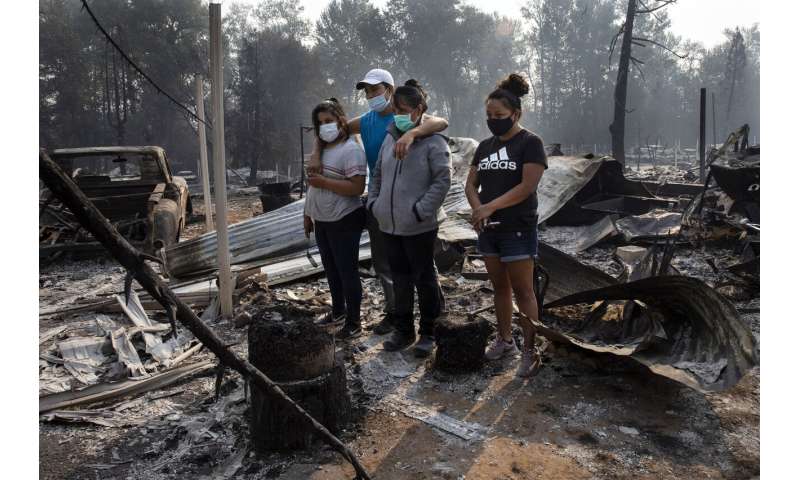
In this Sept. 10, 2020, file photo, The Reyes family looks at the destruction of their home at Coleman Creek Estates mobile home park in Phoenix, Ore. The area was destroyed when a wildfire swept through on Sept. 8. (AP Photo/Paula Bronstein, File)
-
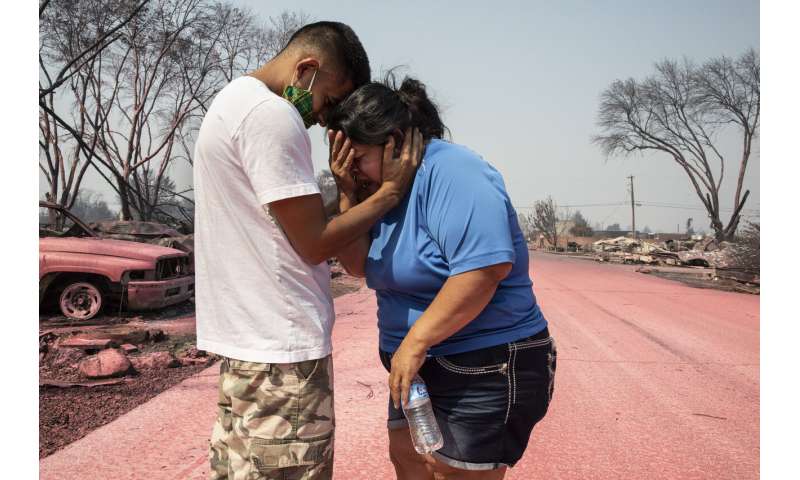
In this Sept. 10, 2020, file photo, Dora Negrete is consoled by her son Hector Rocha after seeing their destroyed mobile home at the Talent Mobile Estates, in Talent, Ore., after wildfires devastated the region. Two unusual weather phenomena combined to create some of the most destructive wildfires the West Coast states have seen in modern times. (AP Photo/Paula Bronstein, File)
-
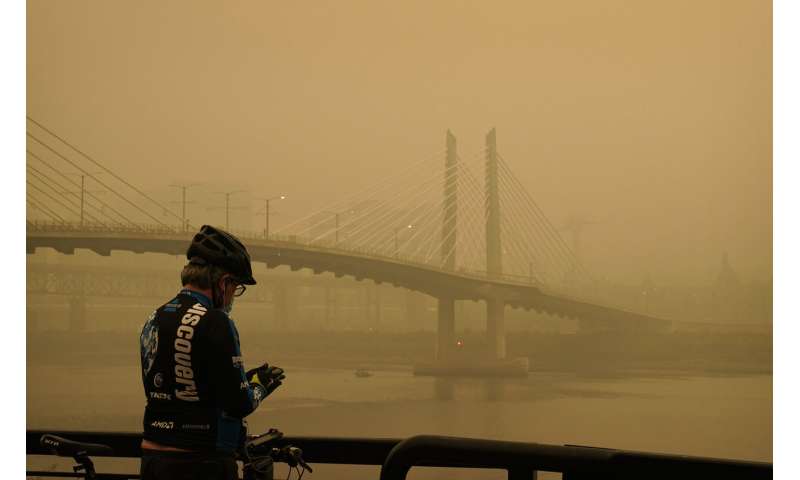
In this Sept. 12, 2020, file photo, a man stops on his bike along the Willamette River as smoke from wildfires partially obscures the Tilikum Crossing Bridge in Portland, Ore. Two unusual weather phenomena combined to create some of the most destructive wildfires the West Coast states have seen in modern times. (AP Photo/John Locher, File)
-
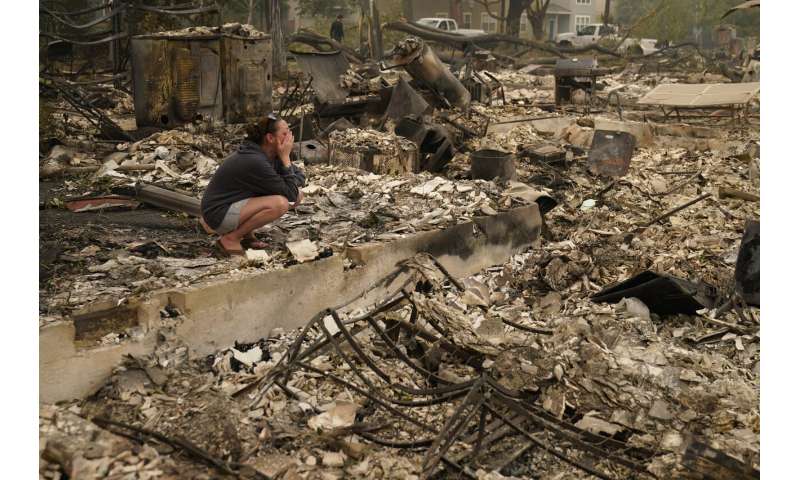
In this Sept. 11, 2020, file photo, Desiree Pierce cries as she visits her home destroyed by the Almeda Fire in Talent, Ore. “I just needed to see it, to get some closure,” said Pierce. Two unusual weather phenomena combined to create some of the most destructive wildfires the West Coast states have seen in modern times. (AP Photo/John Locher, File)
-
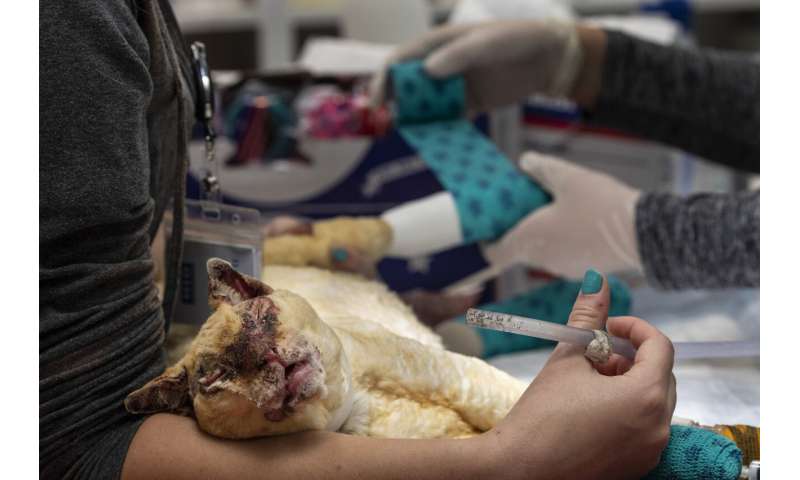
In this Sept. 12, 2020, file photo, an injured cat named Prince is treated for third degree burns on his paws, stomach and face by technician assistant Kaity Kelsey, left, and vet assistant Kayla Weisz, right, both from Medford, Ore., at the Southern Oregon Veterinary Specialty Center (SOVSC), which is a 24/7 hospital dealing with rescued animals from the wildfires devastating the region in Central Point, Ore. Two unusual weather phenomena combined to create some of the most destructive wildfires the West Coast states have seen in modern times. (AP Photo/Paula Bronstein, File)
-
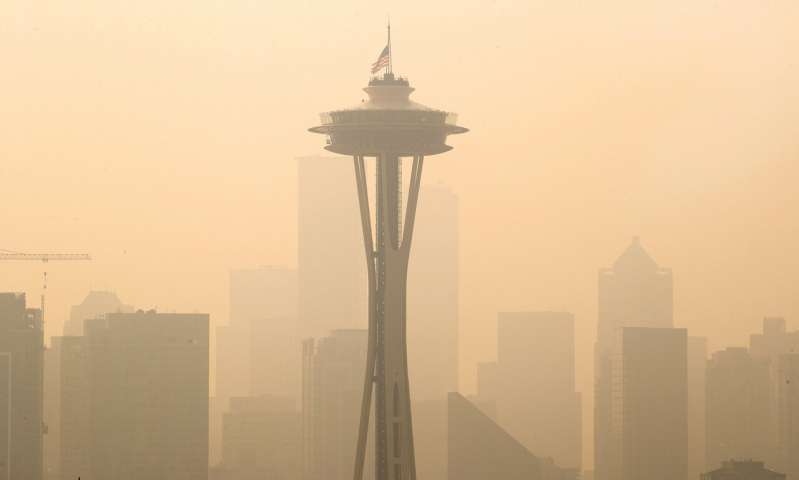
In this Sept. 11, 2020, file photo, an American flag on top the Space Needle was lowered to half-staff today by the Seattle Fire Department to remember those who lost their lives on 9/11, Friday, Sept. 11, 2020. Thick smoke from wildfires burning across Washington, Oregon and California makes seeing the Space Needle and downtown Seattle nearly impossible in this view from Queen Anne Hill. (Mike Siegel/The Seattle Times via AP, File)
-
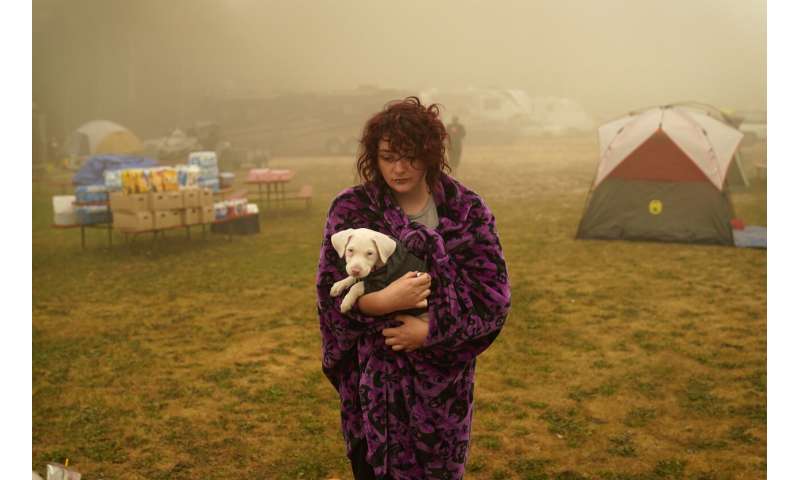
In this Sept. 13, 2020, file photo, Shayanne Summers holds her dog Toph while wrapped in a blanket after several days of staying in a tent at an evacuation center at the Milwaukie-Portland Elks Lodge in Oak Grove, Ore. “It’s nice enough here you could almost think of this as camping and forget everything else, almost,” said Summers about staying at the center after evacuating from near Molalla, Oregon which was threatened by the Riverside Fire. (AP Photo/John Locher, File)
-
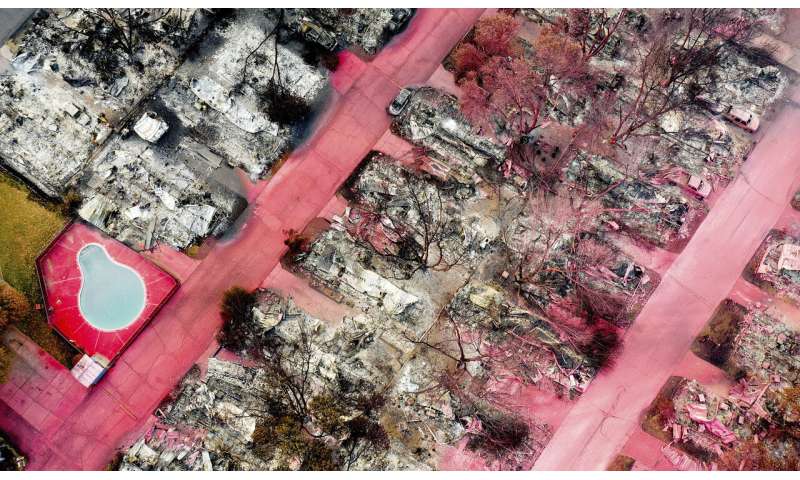
In this Sept, 15, 2020, file photo, taken with a drone, fire retardant blankets leveled homes in Talent, Ore., after the Almeda Fire tore through the area. Two unusual weather phenomena combined to create some of the most destructive wildfires the West Coast states have seen in modern times. (AP Photo/Noah Berger, File)
More than 38,000 people are still not able to return home in California, Gov. Gavin Newsom said Wednesday. Some 4,000 people remain in shelters in Oregon, according to the American Red Cross.
Some no longer have homes to return to. About 1,600 homes were destroyed in Oregon, the state Office of Emergency Management said, and 4,200 structures burned in California.
For some of those whose homes have survived, it’s too dangerous to return.
With the fire season not yet over, residents are praying for a respite before the next batch of large wildfires.
Fires continue to rage in US as smoke reaches Europe
© 2020 The Associated Press. All rights reserved. This material may not be published, broadcast, rewritten or redistributed without permission.
Citation:
Lightning storm, easterly wind: How the wildfires got so bad (2020, September 17)
retrieved 17 September 2020
from https://phys.org/news/2020-09-lightning-storm-easterly-wildfires-bad.html
This document is subject to copyright. Apart from any fair dealing for the purpose of private study or research, no
part may be reproduced without the written permission. The content is provided for information purposes only.
if you want to watch Movies or Tv Shows go to Dizi.BuradaBiliyorum.Com for forums sites go to Forum.BuradaBiliyorum.Com
If you want to read more Like this articles, you can visit our Science category.



